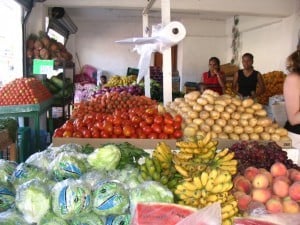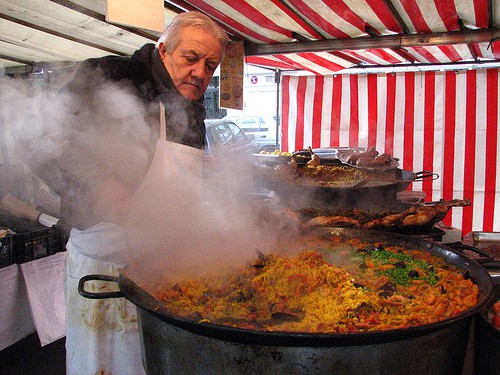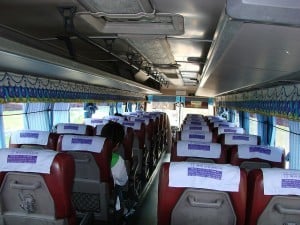
Image credit: Shawn Ford
Travel can become extremely affordable when you learn how to use the local resources. Depending on where you travel to, it could make your trip even cheaper than just staying home! In earlier posts I talked about how to overcome the biggest expenses of airfare and lodging by using frequent flyer miles and staying with couchsurfers or in hostels. I’ll discuss other lodging options in future e-mails, but those are the main ways I save when I travel. After those big expenses, the next big money pits are food and ground transportation. However, if you learn to use the resources that the locals use, you may find you spend even less than you do on food and transportation at home, especially in some of the world’s cheaper destinations, such as many countries in Latin America and Southeast Asia.
Food

Image credit: Megan
If you carry some very basic utensils with you–a shallow bowl and a spork, for instance–and maybe a butter knife or pocket knife–you can buy food at the grocery store and make yourself a picnic meal just about anywhere. Sandwiches, chips and dip, fresh fruits and veggies, granola and milk, yogurt, cheese and crackers, and wraps are just some of many possible options for easy picnic lunches.
If you’re able to heat up some water (in a hostel or couchsurfing host’s kitchen, or in a hotel room coffee pot, for example), you can also make instant mashed potatoes, instant soups, ramen noodles, and quick oats or cream of wheat cereal, to name a few options. Shop at the markets and grocery stores where the locals shop and eat many meals for the price of just one meal at a nice restaurant!
For an easier meal or more hearty dinner, a lot of street vendors sell good hot food for much less than what you would pay in a restaurant. In Nicaragua my two friends and I went to the market where the locals shopped and bought fresh bread, a bag of avocados, a bunch of bananas and some hot, fresh tamales from a street vendor and had a filling meal (with some food left over for dinner!) for less than $1 each.

Image credit: Kurman Communications, Inc.
If you can even reduce your restaurant meals to one a day instead of every single meal, you’ll save a huge amount of money over just a few days.
Ground Transportation

Image credit: Michael Goodine
If you can avoid renting a car, I highly recommend it. Read up on your destination to see what kinds of transportation options are available. Car rentals can be very expensive, can eat up a large portion of your travel budget, and are often unnecessary (though not always–and for those times you have to rent a car, I’ll be writing another post with tips on how you can save, so keep watching this blog). If your destination has a good bus service or train service, you may end up saving hundreds by using those. Not only do you save on the cost of the rental itself, but you also save on gas, parking, tolls, insurance, and any other costs associated with driving. It may take a bit longer, but you can sit back and enjoy the view while someone who knows the local routes and laws does all the work of driving, and save yourself the stress and hassle of trying to navigate through an unknown area.
My husband Keith and I spent 6 weeks in New Zealand last year. Instead of renting a car for those 6 weeks, we bought a 17-trip pass on one of the bus companies (nakedbus.com) for less than $250 each. This worked out to less than $12 per day total for our transportation costs–no fees for parking, gas, insurance or anything else! In most cases the bus went everywhere we needed it to, but when we needed to reach a remote trailhead we could usually find shuttles, and often we simply hitchhiked, which is fairly safe in New Zealand (I wouldn’t recommend it just anywhere, though–do your research before hitchhiking in new places).
In addition to bus systems, some countries–such as India–also have fairly good train systems. Learn about your options before renting a car or signing up with an expensive tour!
Another thing I try to avoid in most cases is taxis. In the larger cities of New Zealand, such as Christchurch, there were city bus systems as well, which we rode around on for a few dollars. Almost all the major cities of the world have metro systems too, which work pretty much the same way everywhere you go. It pays to take a little bit of time to learn the transportation system and use it rather than relying on taxis or rental cars.
If you do decide to ride the public transportation, it becomes especially important to pack light. Once you get used to packing everything you need into one carry-on sized backpack, you won’t want to carry around heavy luggage again. I’ll write more about packing in a different post.
By riding around on the transportation that the locals use, and shopping and eating where the locals shop and eat, you will save a bundle of money. So much so, that when you combine these strategies with frequent flyer miles and couchsurfing or other inexpensive lodging options and choose an affordable destination, you may actually spend less money traveling than you would just staying home!
Are there any other local resources you use when you travel? Do you have any questions? Fire away in the comments below!
There is one more thing you can do to make your travels even more inexpensive, safe, and enjoyable: learn a few basics of the local language. I’ll talk more about that in my next “How To” post!



Pingback: Vilcabamba | Lily Ann Fouts()